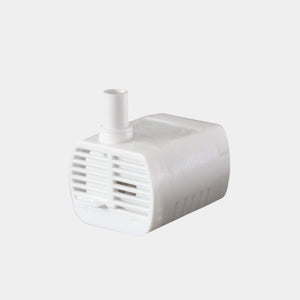Reading time: 10 minutes
Who hasn't been there? You lace up your running shoes full of enthusiasm, set off, and after just a few minutes, you feel like you've just completed a marathon. Your breathing is labored, your sides ache, and you desperately ask yourself, "Why do I get out of breath so quickly when I jog?" Don't worry, you're not alone! Proper breathing technique while running is an art that even experienced runners continually refine. In this article, we'll take a detailed look at the topic of breathing while running and provide you with valuable tips on how to improve your running performance through optimized breathing.
Why is proper breathing so important when running?
Before we delve into the ins and outs of different breathing techniques, let's briefly consider why efficient breathing is so crucial when running. Imagine your body as a finely tuned orchestra. Every instrument—or in this case, every organ and muscle—must be in perfect harmony for optimal performance. Breathing is the conductor, holding everything together and setting the pace.
Efficient breathing supplies your muscles with much-needed oxygen, helps regulate blood pH, and supports the removal of waste products like carbon dioxide. In short, proper breathing can mean the difference between a tiring struggle and an enjoyable, energizing run.
How should you breathe while running?

This question concerns runners of all levels. The truth is: There is no single perfect breathing technique that is equally suitable for every runner and every situation. Various factors such as your running speed, the duration of the run, and your personal physiology all play a role. However, there are some basic principles that can help you optimize your breathing.
1. Abdominal breathing vs. chest breathing
One of the most important fundamentals is the distinction between abdominal and chest breathing. Abdominal breathing, also called diaphragmatic breathing, is generally considered more efficient and should be preferred when running.
How does abdominal breathing work?
- Breathe deeply into your belly so that your belly bulges outward as you inhale.
- As you exhale, pull your stomach in again.
This type of breathing allows for better use of lung capacity and more efficient oxygen intake. Try it: Place one hand on your stomach and one on your chest. Breathe deeply and notice which hand moves more. The goal is for the hand on your stomach to rise and fall primarily.
2. Nasal breathing vs. mouth breathing
A frequently asked question is, "Should you breathe through your mouth or nose while jogging?" Again, there's no one-size-fits-all answer, but some guidelines can help:
- Nasal breathing : Ideal for slow to moderate runs. The nose filters, warms, and humidifies the air, which is especially beneficial in cold weather.
- Mouth breathing : Allows for greater air intake and is therefore useful during more intense runs or sprints.
- Combined breathing : Many runners breathe through their nose and mouth simultaneously, especially at moderate to high intensity.
A quick practical tip: If you feel like you're running out of breath, try consciously exhaling through your mouth. This often helps relieve the feeling of shortness of breath.
Breathing rhythm: The rhythm of your run
Have you ever considered that your breath can act like a natural metronome while you run? A regular breathing rhythm can not only increase your efficiency but also help you maintain a steady running pace.
The 2:2 method
A popular method is 2:2 breathing. This involves inhaling for two steps and exhaling for two steps. This technique is well-suited for moderate runs and helps many runners find a steady rhythm.
The 3:2 method
For slightly faster runs, or when you feel like you need more air, you can try the 3:2 method. Breathe in for three counts and exhale for two counts. This asymmetrical breathing can also help distribute the load on your internal organs more evenly.
Individual customization
Ultimately, it's important to find a rhythm that feels natural and comfortable for you. Experiment with different patterns and listen to your body. Over time, you'll discover which rhythm best suits your running style and pace.
Special breathing techniques for different types of running
Now that we've covered the basics, let's look at specific breathing techniques for different running scenarios.
Slow runs and beginners
For beginners or for slow, relaxed runs, calm, controlled breathing is essential. Here are some tips:
- Focus on nasal breathing : Try to breathe through your nose as much as possible. This helps maintain a moderate pace and prevents overexertion.
- Practice pursed-lip breathing : Exhale through slightly closed lips. This creates a slight resistance and helps empty your lungs more effectively.
- Maintain an upright posture : A straight posture allows your lungs to expand fully.
Fast runs and interval training
At higher intensities, your body will need more oxygen. Here are some strategies:
- Switch to the mouth-nose combination : Breathe in through both your mouth and nose to ensure maximum air supply.
- Shorten your breathing rhythm : for example, go from 2:2 to 1:1 breathing.
- Focus on powerful exhalation : A strong exhalation helps to efficiently remove stale air from the lungs and makes room for fresh oxygen.
Uphill and downhill

Mountain running places special demands on your breathing:
- Uphill : Shorten your strides and adjust your breathing rhythm accordingly. 2:1 breathing (inhale two steps, exhale one step) often helps.
- Downhill : Be careful not to breathe too shallowly. Use the easier sections to breathe deeply and oxygenate your body.
Common breathing problems when running and how to solve them
Even with the best technique, runners can still struggle with breathing problems. Let's look at some common problems and possible solutions.
shortness of breath
Problem : "Why do I get out of breath so quickly when jogging?"
Solutions :
- Check your pace: Shortness of breath is often a sign that you are running too fast.
- Practice breathing exercises regularly to improve your lung capacity.
- Maintain an upright posture to give your lungs maximum space.
side stitch
Problem : Sharp pain in the side that makes breathing difficult.
Solutions :
- Try changing your breathing rhythm. It often helps to exhale on the side of the stabbing when the opposite foot touches the ground.
- Slow down and breathe deeply and evenly.
- Gently stretch the affected side while running.
Dry throat or cough
Problem : Can irritate the respiratory tract, especially in cold weather or dry environments.
Solutions :
- Breathe more through your nose to warm and humidify the air.
- In cold weather, wear a scarf or mask over your mouth and nose.
- Drink plenty of water before and during your run.
Breathing exercises to improve your running performance
As with any aspect of running, practice makes perfect. Here are some effective breathing exercises you can incorporate into your training plan:
1. Diaphragmatic breathing while lying down
- Lie on your back and place one hand on your stomach.
- Breathe deeply through your nose and let your belly rise.
- Breathe out slowly through your mouth and feel your stomach drop.
- Repeat this for 5-10 minutes.
2. Alternate breathing
This yoga exercise can improve your breath control:
- Sit comfortably and close your right nostril with your thumb.
- Breathe in through the left nostril.
- Now close the left nostril with your ring finger and open the right one.
- Exhale through the right nostril.
- Repeat this cycle for several minutes.
3. Breathing posture
- Take a deep breath and hold it for 10-15 seconds (or as long as you can).
- Breathe out slowly.
- Repeat this several times.
This exercise can increase your lung capacity and strengthen your respiratory muscles.
The psychological component of breathing
Often underestimated, but immensely important: the mental side of breathing. Conscious breathing can not only improve your physical performance, but also reduce stress and promote your mental strength.
Mindfulness while running
Try to bring your attention back to your breath while running. This can have an almost meditative effect and helps you stay in the moment rather than being distracted by exhaustion or negative thoughts.
Breathing as a focus point
During difficult phases of a run, whether during a tough workout or a race, focusing on your breathing can serve as an anchor. Instead of focusing on fatigue or pain, focus your attention on your breathing rhythm. This can help you get through difficult sections.
The path to optimal running breathing
Developing the perfect breathing technique while running is a process that requires time and practice. Remember: every runner is unique, and what works for one may not necessarily be ideal for another.
Here are the most important points summarized again:
- Experiment with different breathing techniques and find out what works best for you
- Make sure you take deep abdominal breaths that fully utilize your lung capacity.
- Adjust your breathing rhythm to your running speed and intensity.
- Practice breathing techniques regularly, even when not running.
- Use your breathing as a mental tool to promote focus and relaxation.
Remember: As with all aspects of running, consistency is key. The more you practice and pay attention to your breathing, the more natural and efficient it will become over time.
Special breathing techniques for advanced runners
Once you have mastered your basic breathing technique, you can try more advanced methods to further enhance your performance:
1. Rhythmic breathing
This technique aims to distribute the impact evenly on both sides of the body when running:
- Use an odd breathing rhythm, e.g. 3:2 (three steps in, two out) or 5:3.
- This ensures that you don't always breathe in or out on the same side, which distributes the strain more evenly.
2. Stacking Breath Technique
This technique helps to fill your lungs to the maximum:
Breathe in and out normally.
- On your next inhalation, fill your lungs about 3/4 full.
- Breathe out briefly and then in again immediately to fill your lungs completely.
- Then breathe out completely.
This technique can be especially useful for hill runs or intervals.
3. Breath Holding Technique
This advanced technique can help increase your CO2 tolerance:
- Run for 10-15 seconds with normal breathing.
- Then hold your breath for 5-10 seconds while running.
- Return to normal breathing.
- Repeat this cycle several times during your run.
Caution: This technique should only be practiced by experienced runners and after consulting a trainer or doctor.
The role of breathing in regeneration

The importance of proper breathing doesn't end when your run is over. Conscious breathing can also support your recovery and regeneration:
Cooldown breathing
- After your run, walk for a few minutes and focus on taking deep, even breaths.
- This helps normalize your heart rate and put your body into rest mode.
Relaxation breathing
- Practice a calming breathing technique after running or before going to bed.
- A popular method is the 4-7-8 technique: inhale for 4 seconds, hold your breath for 7 seconds, exhale for 8 seconds.
Breathing meditation
- Take time for a short breathing meditation to reduce stress and promote mental relaxation.
- Simply concentrate on your natural breathing rhythm and let distracting thoughts pass by.
Frequently Asked Questions (FAQ)
To give you even more practical insights, we answer some of the most frequently asked questions about breathing while running:
How can you last longer while jogging in terms of breathing?
- Start slowly and gradually increase speed and distance.
- Practice breathing exercises regularly to strengthen your respiratory muscles.
- Maintain a steady breathing rhythm.
- Drink plenty of water to keep your airways moist.
- Incorporate interval training into your training plan to improve your aerobic capacity.
What can cause incorrect breathing?
Incorrect breathing while running can have various negative effects:
- Premature fatigue due to inefficient oxygen uptake.
- Increased risk of side stitches.
- Overacidification of the muscles due to insufficient CO2 release.
- Increased stress on the body, which can impair regeneration.
- Possible hyperventilation , which may lead to dizziness or lightheadedness.
How do you practice nasal breathing?
Training nasal breathing requires patience and consistent practice:
- Start with short, slow runs and breathe only through your nose.
- Practice nasal breathing in everyday life, for example when walking or climbing stairs.
- Practice breathing exercises such as alternate nostril breathing from yoga.
- Slowly increase the intensity and duration of your nasal breathing runs.
- Be patient - it may take weeks or months for your body to fully adjust.
What breathing rate should you have when running?
The ideal breathing rate varies depending on running speed and individual fitness. Here are some guidelines:
- Slow jogging: about 2:2 or 3:3 (steps per inhalation and exhalation)
- Moderate tempo: 2:2 or 3:2
- Fast running: 2:1 or even 1:1
More important than a specific frequency, however, is that your breathing feels natural and not forced.
How do you avoid forced breathing?
Forced breathing, where you exhale against resistance, can impair performance and be uncomfortable. Here's how to avoid it:
- Make sure you maintain a relaxed, open posture.
- Focus on a full, deep exhalation.
- Avoid holding your breath or "squeezing."
- Adjust your pace if you notice that you are starting to breathe forcefully.
- Practice deep abdominal breathing regularly to internalize it.
Your path to breathing-optimized running
Breathing properly while running is a skill that requires time, patience, and practice. But the benefits—from improved performance to increased enjoyment of running—more than make up for the effort. Remember that every runner is unique. Experiment with different techniques and find what works best for you.
Whether you're a beginner just discovering the joy of running or a seasoned marathon runner looking for that winning edge, efficient breathing can be the key to your next breakthrough.
Don't forget the importance of post-run recovery for your respiratory system. Using a mini saline , a small salt air device for your home, can work wonders here. The salty air can help soothe, cleanse, and revitalize your respiratory system for your next run. Combine using a mini saline with conscious breathing exercises for relaxation to optimize your recovery and best prepare your respiratory system for future runs.
So, lace up your running shoes, take a deep breath, and set off for new running heights. With every breath, you'll get closer to your goal. Happy running, and above all: savor every breath, both during the run and during your well-deserved recovery phase!



